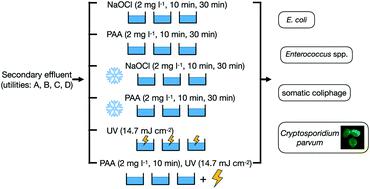当前位置:
X-MOL 学术
›
Environ. Sci.: Water Res. Technol.
›
论文详情
Our official English website, www.x-mol.net, welcomes your
feedback! (Note: you will need to create a separate account there.)
Inactivation of E. coli, Enterococcus spp., somatic coliphage, and Cryptosporidium parvum in wastewater by peracetic acid (PAA), sodium hypochlorite, and combined PAA-ultraviolet disinfection
Environmental Science: Water Research & Technology ( IF 3.5 ) Pub Date : 2019-11-15 , DOI: 10.1039/c9ew00837c Abdulrahman H. Hassaballah 1, 2, 3, 4, 5 , Tanmay Bhatt 1, 2, 3, 4, 5 , Jeremy Nyitrai 1, 2, 3, 4, 5 , Ning Dai 1, 2, 3, 4, 5 , Lauren Sassoubre 1, 2, 3, 4, 5
Environmental Science: Water Research & Technology ( IF 3.5 ) Pub Date : 2019-11-15 , DOI: 10.1039/c9ew00837c Abdulrahman H. Hassaballah 1, 2, 3, 4, 5 , Tanmay Bhatt 1, 2, 3, 4, 5 , Jeremy Nyitrai 1, 2, 3, 4, 5 , Ning Dai 1, 2, 3, 4, 5 , Lauren Sassoubre 1, 2, 3, 4, 5
Affiliation

|
Wastewater disinfection is important to protect human and ecosystem health. Peracetic acid (PAA) could be used as a disinfectant for wastewater and has the advantage of being less toxic to aquatic species and forming fewer known disinfection byproducts than traditionally used chlorine. Assessment of the relative performance of PAA and chlorine at different exposures and seasonal temperatures is still needed to promote utility adoption especially in cold environments and for non-traditional applications such as water reuse. Additionally, the combination of PAA and UV disinfection has the potential to augment inactivation especially against more resistant microorganisms. In this study, the disinfection efficiency of PAA and chlorine was compared for four microorganisms: two fecal indicator bacteria (E. coli and Enterococcus spp.), a virus (somatic coliphage), and a protozoan (Cryptosporidium parvum). Experiments were conducted in authentic secondary wastewater samples to compare PAA and NaOCl disinfection at two C·t values (20 mg min l−1 and 60 mg min l−1) and two temperatures (room temperature and 4 °C), investigate combined PAA plus UV treatment, and evaluate PAA and PAA plus UV disinfection after 10 min and 24 h. PAA and NaOCl disinfection efficiency was comparable for E. coli, Enterococcus spp. and somatic coliphage at a C·t of 60 mg min l−1 (2 mg l−1, 30 min) but not at 20 mg min l−1 (2 mg l−1, 10 min). Neither PAA nor NaOCl disinfection reduced concentrations of Cryptosporidium parvum oocysts spiked into secondary wastewater. At a winter-relevant temperature (4 °C), NaOCl was more effective against E. coli and Enterococcus spp. than PAA regardless of exposure, while both PAA and NaOCl achieved comparable somatic coliphage inactivation. The combined use of PAA and UV treatment appear to have achieved higher log reductions than the use of PAA only for E. coli and somatic coliphage, and of UV only for E. coli. Log reductions after PAA and PAA plus UV treatments continued to increase up to 24 h after exposure which has implications for distribution systems for reclaimed water used for irrigation purposes. The results presented here support the use of PAA as an alternative wastewater disinfectant to chlorine and as a complimentary disinfectant to UV.
中文翻译:

通过过乙酸(PAA),次氯酸钠和联合PAA-紫外线消毒灭活废水中的大肠杆菌,肠球菌,体细胞噬菌体和小隐孢子虫
废水消毒对于保护人类和生态系统健康非常重要。过氧乙酸(PAA)可以用作废水的消毒剂,其优点是对水生生物毒性较小,并且与传统的氯气相比,形成的已知消毒副产物更少。仍需要评估PAA和氯在不同暴露量和季节性温度下的相对性能,以促进公用事业的采用,尤其是在寒冷的环境中以及非传统应用(例如中水回用)中。另外,PAA和紫外线消毒的组合具有增强灭活作用的潜力,尤其是对更具抵抗力的微生物的灭活作用。在这项研究中,比较了PAA和氯对四种微生物的消毒效率:两种粪便指示细菌(大肠杆菌和肠球菌),病毒(体细胞噬菌体)和原生动物(小隐孢子虫)。在真实的二级废水样品中进行了实验,比较了两种C · t值(20 mg min l -1和60 mg min l -1)和两种温度(室温和4°C)下的PAA和NaOCl消毒,研究了组合的PAA加紫外线处理,并在10分钟和24小时后评估PAA和PAA加紫外线消毒。PAA和NaOCl的消毒效率与大肠杆菌(Enterococcus spp )相当。和在体大肠杆菌噬菌体Ç ·吨60毫克分升的-1(2毫克升-1,30分钟),但不是20 mg min -1(2 mg l -1,10分钟)。PAA和NaOCl消毒均不能降低加标到二级废水中的小隐孢子虫卵囊的浓度。在与冬季相关的温度(4°C)下,NaOCl对大肠杆菌和肠球菌属的细菌更有效。与PAA相比,无论暴露程度如何,PAA和NaOCl均实现了相当的体细胞噬菌体灭活。与仅将PAA用于大肠杆菌和体细胞噬菌体以及仅将UV用于大肠杆菌相比,PAA和紫外线处理的组合使用似乎实现了更高的对数减少。暴露后直至24小时,PAA和PAA加UV处理后的原木减少量持续增加,这对用于灌溉目的的再生水分配系统产生了影响。此处提出的结果支持使用PAA作为氯的替代废水消毒剂和UV的补充消毒剂。
更新日期:2019-11-15
中文翻译:

通过过乙酸(PAA),次氯酸钠和联合PAA-紫外线消毒灭活废水中的大肠杆菌,肠球菌,体细胞噬菌体和小隐孢子虫
废水消毒对于保护人类和生态系统健康非常重要。过氧乙酸(PAA)可以用作废水的消毒剂,其优点是对水生生物毒性较小,并且与传统的氯气相比,形成的已知消毒副产物更少。仍需要评估PAA和氯在不同暴露量和季节性温度下的相对性能,以促进公用事业的采用,尤其是在寒冷的环境中以及非传统应用(例如中水回用)中。另外,PAA和紫外线消毒的组合具有增强灭活作用的潜力,尤其是对更具抵抗力的微生物的灭活作用。在这项研究中,比较了PAA和氯对四种微生物的消毒效率:两种粪便指示细菌(大肠杆菌和肠球菌),病毒(体细胞噬菌体)和原生动物(小隐孢子虫)。在真实的二级废水样品中进行了实验,比较了两种C · t值(20 mg min l -1和60 mg min l -1)和两种温度(室温和4°C)下的PAA和NaOCl消毒,研究了组合的PAA加紫外线处理,并在10分钟和24小时后评估PAA和PAA加紫外线消毒。PAA和NaOCl的消毒效率与大肠杆菌(Enterococcus spp )相当。和在体大肠杆菌噬菌体Ç ·吨60毫克分升的-1(2毫克升-1,30分钟),但不是20 mg min -1(2 mg l -1,10分钟)。PAA和NaOCl消毒均不能降低加标到二级废水中的小隐孢子虫卵囊的浓度。在与冬季相关的温度(4°C)下,NaOCl对大肠杆菌和肠球菌属的细菌更有效。与PAA相比,无论暴露程度如何,PAA和NaOCl均实现了相当的体细胞噬菌体灭活。与仅将PAA用于大肠杆菌和体细胞噬菌体以及仅将UV用于大肠杆菌相比,PAA和紫外线处理的组合使用似乎实现了更高的对数减少。暴露后直至24小时,PAA和PAA加UV处理后的原木减少量持续增加,这对用于灌溉目的的再生水分配系统产生了影响。此处提出的结果支持使用PAA作为氯的替代废水消毒剂和UV的补充消毒剂。











































 京公网安备 11010802027423号
京公网安备 11010802027423号